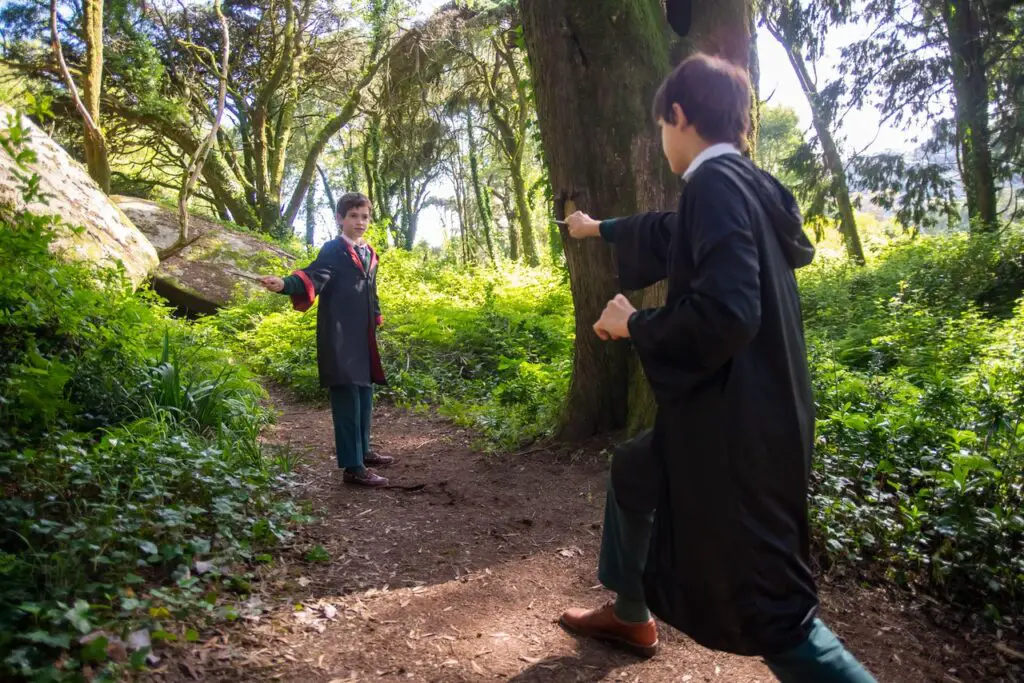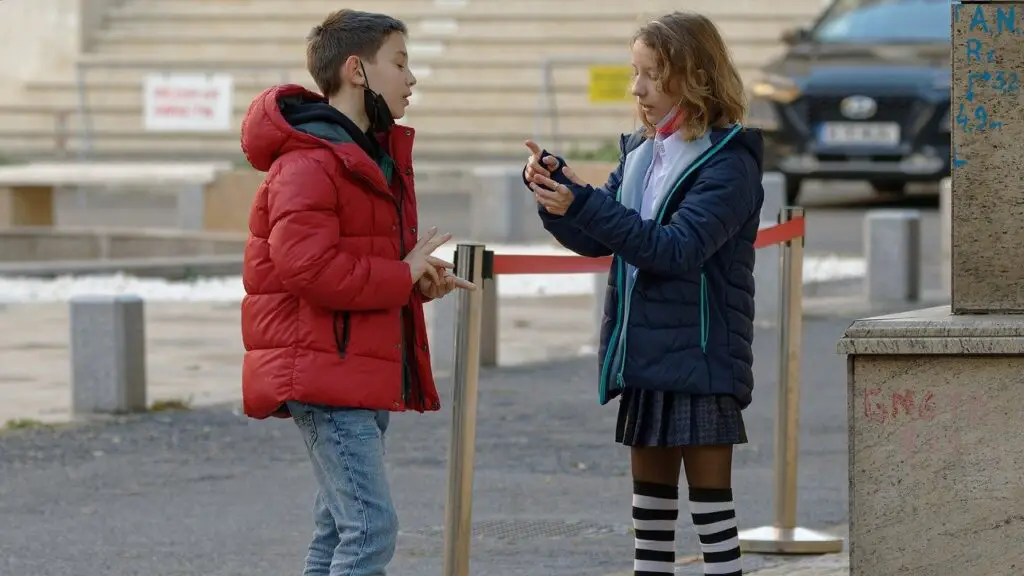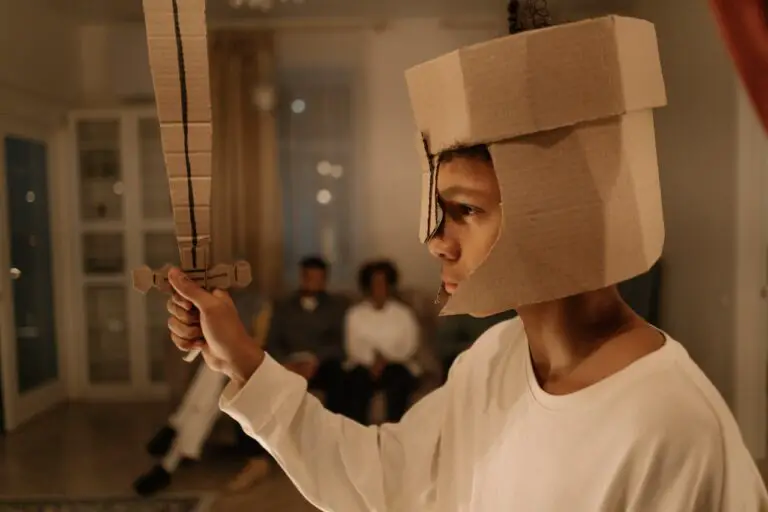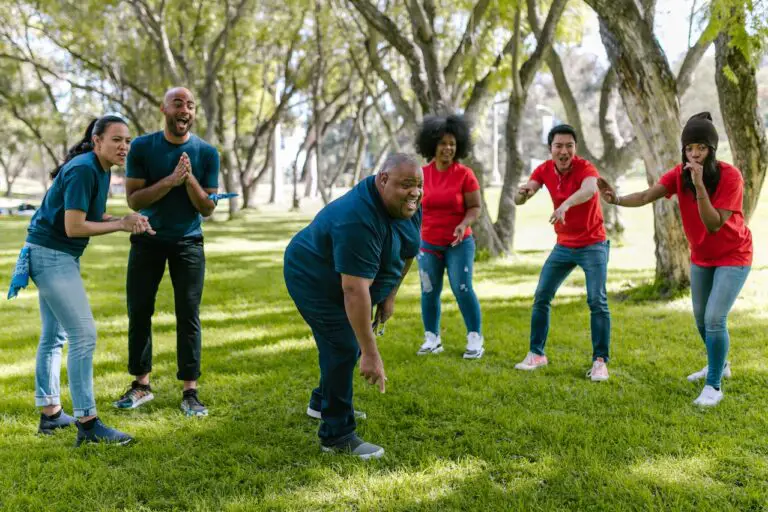Children love role play. If you’ve ever been in a school playground, you’ll have seen kids acting out wild scenarios, fighting battles against invisible enemies, or inviting their teddy bears around for tea.
Charming, right? But how often do you use role play in your EFL/ESL classroom? I’d bet not very often. For a teacher, it’s easier to do worksheets and textbook exercises than get the whole class up and acting. It’s a risk. Kids are hard to manage when they’re excited and things can go wrong quickly.

By reading this article, I hope you’ll gain the confidence and knowledge to run role play sessions with children aged 8-12.
If you’re teaching students 13 or over, head over to my other article Teaching EFL/ESL to Teenagers & Adults With Role Play.
For successful EFL/ESL role plays with children, keep the activity short, focused, sufficiently interesting, and flexible. Brainstorm language you anticipate them needing beforehand. Allow children space to think and develop confidence rather than excessively correcting.
So let’s take a look at what exactly role play is, how to get the best of out it with children, and the best practical methods to implement it which I have developed over the years.

Understanding role play in the EFL/ESL classroom
First of all, it’s vital to understand exactly what role play is. Not only for the teacher, but for the students, too, as if you don’t make expectations clear, children will get confused and stressed.
Role play is the spontaneous acting out of a character in a given scenario. It is not scripted. The character does not have to be from a book or film, instead it can be as simple as “mother” and “son” or “tourist” and “local”.
For example, the classic (and unoriginal) role-play situation from every EFL/ESL instruction book is a restaurant with one student as the waiter/waitress and the other as a customer ordering food. The students enact the conversation through improvisation.
Role play differs from dramatization and simulation, which are alternative learning techniques. Find more about the differences by reading my article Dramatization vs Simulation vs Role Play: Guide for EFL/ESL.
It can last thirty seconds, or thirty minutes. Scenarios have a general goal, but can take a different route depending on how the conversation goes. It’s creative and unpredictable.
Why use role play in the EFL/ESL classroom? There are several reasons. In short, it’s engaging, develops fluency, and can be adapted to every situation.
Getting children up and speaking English is so important to their confidence. Especially in classes of 20 or more, each pupil doesn’t get much chance to speak, so any opportunity you can get, you should use.
It also helps you consolidate language, elicit new vocabulary and assess where your students are at.
For all the benefits of role play in EFL/ESL, read my article Why All EFL/ESL Teachers Should Use Role Play Activities.
For children, it’s particularly powerful given they do this kind of thing in their free time. Kids love taking the role of other people. By tapping into that innate sense of play, your students get fully engaged in the activity.
I also like how it allows less academic students to shine. When focus is placed on grammar exercises, writing tasks and the intellectual side of learning a language (as it often is), the same few children rise to the top.
However, in a role-play situation, students who don’t always get a 10 in tests show their capacities as creative communicators.
Okay, so we’ve established that role play with EFL/ESL children is great. But how do we do it?
Getting the best out of role play with EFL/ESL children – the balance
This article is for children aged 8 to 12. Any younger, and the activity becomes too complex. And if your children have a very low level of English, it might be one to avoid. They need to be able to speak in simple sentences as a minimum.
Teacher skill and confidence is vital to success. The aim is to create an engaging activity while maintaining control and practicing new language. This balance is key. You must get it right to enjoy the benefits of role play.
It isn’t easy. If the children in your class are very excitable or badly behaved, things can get out of control quickly, especially in large groups. Your trust in them determines how much freedom to give.
The two major problems that can occur are overly physical acting and failure to include target language.
- Overly physical acting is when children get too excited about the activity and start running around or grabbing/pulling/pushing other students.
- Failure to include target language is another product of over-excitement. The desire to communicate and advance the scenario leads to children talking in their native language, or using gestures instead of trying to speak English.
For more common issues with role play activities and how to fix them, read my article 5 Problems to Avoid With Role Play in EFL/ESL + Solutions.
If these things happen, the activity is failing. You may have to restrict the freedom and spontaneity you give them to stay in control.
On the flip side, limiting the fun and creativity reduces the power of role play. When students don’t feel agency, they engage less.
Lots of role play activities you can find elsewhere online are extremely structured, with students parroting sentences from a sheet. You may be tempted to use these. But don’t. Firstly, they’re not really role play, and secondly, they’re boring. It’s just a forced repetition exercise.
That’s not to say you shouldn’t provide appropriate language, but you should let students use their own words.

As a teacher, you have to find the right balance between excitement and learning.
My approach is to gauge the class beforehand, and come in with a suitable level of strictness. Make your expectations crystal clear beforehand. Let them know if they’re allowed to get up and move around and if they can make lots of noise.
Then watch how it unfolds and adjust accordingly. If things get out of control quickly, rein them in, or if the energy is low, inject a bit of excitement.
TOP TIP: Model a role play activity with a confident student or a teaching assistant. Show them how to do it right.
The first few attempts won’t be perfect. Both you and your students are getting used to the activity, so don’t give up if things don’t immediately start well.
Figure out how much pre-teaching you need to do so they can talk about the topic. If it’s going to be a lot, maybe the topic is too hard for them.
TOP TIP: Sometimes, students do the activity well for five or ten minutes, then their focus wanes and things get silly. You’ve learned something there. Set a time limit for the activity.
Each class will behave differently. Small private class groups might need you to lead the way and be silly before they have the confidence to do it themselves. Big school classes often need a firm but encouraging hand to guide them.
When you find the right balance, you’ve hit the jackpot.

Practical steps for role play activities with children in EFL/ESL
Now we’ve got an idea of how to manage children in role play, let’s get to how to some practical steps.
This is an approach I’ve developed over time, and, in my humble opinion, is better than the majority of role play activities you can find online because it allows real creativity and spontaneity.
Group sizes: 2-3
Groups should be small. Two or three is perfect. Any more and things get confusing and people get left out. If in doubt, go with pairs, but if you have an odd number of students, threes are fine.
Scenario choice
For most children, the typical role-play situations online are pretty dull. A tourist asking a local for directions, or a customer in a restaurant ordering food from the waiter isn’t bad… but can you make it a bit more fun?
Let’s say the tourist is a prince/princess from a distant country and wants a tour around the town. Or maybe the customer at the restaurant finds a spider in their salad!
TOP TIP: Choose scenarios and roles which are relevant and connected to your students interested. Can you include elements from films, music and sports that they like? Make scenarios as wild and silly as you like, as long as they stay within the established balanced we spoke about earlier.
And make sure there’s at least some use of new language. Base the scenario on something related to the topic you’re studying, so you can gently practice vocab and grammar structures.
Role assignment
Before any role play takes place, you have to establish roles and assign them to members of the group.
Who is the tourist prince/princess and who is the local guide? What does each person want?
If you’re working with a large class, divide them into groups of 2 or 3 and assign them a letter A, B, or C. The main actors are A and B, while C is an optional supplement which isn’t necessarily required for the scenario, but can contribute.
Tell each student who they are according to their letter. Here’s an example.

You can do this role play without the role of C, so it’s suitable for pairs as well as groups of 3.
Make sure everyone is clear on their role.
TOP TIP: If you do multiple scenarios in one session, rotate the roles so one person doesn’t always get the supplementary role or end up being the grumpy parent.
If you’re looking for more great role-play scenarios to use with kids, check out my 5 Exciting EFL/ESL Role Play Scenarios for Kids (+ tips).
Elicitation and pre-teaching
Before you start the role play, it’s a good idea to elicit some relevant vocabulary using a class brainstorm. Write words on the board so students can reference them as needed.
If there’s a particular grammar structure (e.g. present continuous) you’re hoping students will use, remind them of it.

Be careful not to force this, though. This is the fundamental problem I have with most role-play activities online – they make the students use specific language and structures so it becomes overly scripted and, as a result, less exciting.
The pre-taught and elicited language should help children communicate rather than being the focus of the activity.
Modelling an example
The best way to set expectations and show how to use the brainstormed language is to model it beforehand. If you have an assistant teacher in class, do it with them. If not, a confident student is good.
Enact a role play for everyone to watch, then they can use what they saw for inspiration and guidance. Less confident students may copy a lot of what you did – that’s fine. Others will come up with their own wacky versions.
Monitoring and supplying language
The teacher shouldn’t take part in the role play. Instead, float around the classroom and focus on two things. First, maintain the balance of engagement and discipline. Second, be a resource for children when they can’t find a word, or need a bit of support in the direction of the scenario.
For example, if they finish very quickly, add a new element to the story. You could switch the role of student C to a new customer who comes in and buys the same t-shirt A wanted in the first place (if they didn’t already convince their parent).
And did they go through the process of buying the t-shirt? How did they pay? What consequences does it have for the child?
Optional: Performance
To really challenge your students’ confidence and fluency, you could have pairs/groups perform a role play in front of their peers at the end of the session.
This is a great way to judge how well they’re doing the activity and pick up on any language to build upon.
However, be warned. If students know they’re going to perform it, they’ll prepare a script while practicing. This defeats the point of the role play.

Also, it can get boring to watch all the other children perform, especially if some like to drag it out and hog all the attention.
And shy kids will hate it. If you want them to dread every role-play session, thrusting them in the spotlight without much structure or help will cripple their confidence.
For the best use of performances, I recommend choosing just one pair/group at the end of the session who feel confident and comfortable about doing it.
Conclusion
Doing role plays with children in an EFL/ESL classroom requires bravery. But it’s worth it.
The results are spectacular, and your class will be much more engaged with the language they learn, knowing they can use it in a practical situation.
In some ways, children 8-12 are the easiest age to role play with. It comes naturally to them, and they don’t have the embarrassment factor you get with teens and adults.

On the other hand, they can be the hardest to manage since they struggle to control their energy and excitement levels.
For me, once you get the balance sorted, role play is the best activity you can do to develop your students’ speaking skills. So don’t miss out! Take courage and competence from this article and get some role play in your next lessons!
For more information and guidance on role play in the EFL/ESL classroom, check out all my articles on the subject:
Why All EFL/ESL Teachers Should Use Role Play Activities
Dramatization vs Simulation vs Role Play: Guide for EFL/ESL
5 Problems to Avoid With Role Play in EFL/ESL + Solutions
How to Teach Children EFL/ESL With Role Play: Best tips
Teaching EFL/ESL to Teenagers & Adults With Role Play
5 Awesome EFL/ESL Role-play Scenarios for Teens (+ tips)
5 Exciting EFL/ESL Role Play Scenarios for Kids (+ tips)
5 Engaging EFL/ESL Role Play Activities for Adults (+ tips)







